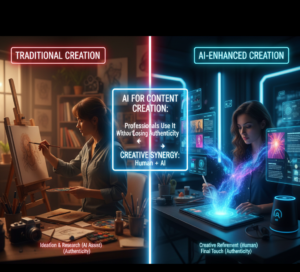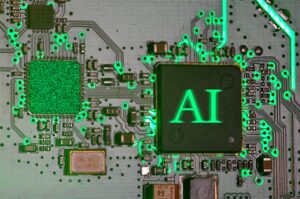Artificial Intelligence in Retail: Individualized Shopping Experiences and Inventory Management

Artificial Intelligence in Retail: Individualized Shopping Experiences and Inventory Management
The retail sector is now undergoing a significant period of change. Retailers are compelled to discover innovative methods for providing value and maintaining their competitive edge due to the growing number of competitors, the changing tastes of consumers, and the expanding popularity of electronic commerce. This transformation is centered on artificial intelligence (AI), which assists companies in developing customized shopping experiences and handling their inventory with a higher degree of precision.
Organizations that use artificial intelligence into their retail operations have the potential to enhance consumer engagement, save expenses, and make more informed business choices.
Artificial intelligence’s function in the retail industry
The application of artificial intelligence in retail entails the use of machine learning, predictive analytics, natural language processing (NLP), and computer vision in order to improve the experiences of customers and expedite processes that are carried out in the background. Artificial intelligence (AI) is making retail more intelligent and more customer-focused, as seen by the use of AI in online recommendations and real-time inventory management, among other applications.
Shopping experiences that are tailored to the individual with the assistance of artificial intelligence
Personalization is one of the most significant ways in which artificial intelligence (AI) is transforming the retail industry. When it comes to buying, today’s customers anticipate that they will get experiences that are customized to suit their requirements, preferences, and actions.
Suggestions for Products
The purpose of artificial intelligence (AI) algorithms is to assess the purchasing habits, browsing history, and demographic information of customers in order to recommend items that are most relevant to them. Not only does this result in a rise in revenue, but it also enhances consumer happiness.
Pricing That Changes throughout Time
Pricing engines that are driven by artificial intelligence modify prices in real time according to demand, competition activity, and consumer behavior. This guarantees that merchants continue to be competitive while at the same time optimizing their profit margins.
Chatbots and Virtual Assistants
Customers who are looking for assistance with product searches, order tracking, or tailored offers may get immediate response from chatbots that are powered by artificial intelligence. It is also possible for virtual shopping assistants to simulate the function of a sales associate who works in a store.
Visual Search
Customers are able to submit pictures of things and rapidly locate items that are comparable to them thanks to computer vision. This functionality serves as a bridge to connect the points between inspiration and purchasing.
Sentiment analysis
Artificial intelligence (AI) makes it easier for businesses that sell to consumers to comprehend consumer sentiment and adjust their marketing tactics appropriately by studying reviews and social media discussions.
Artificial Intelligence for Inventory Management
Inventory management has always been one of the most significant obstacles that retail businesses have had to overcome. Stockouts lead to lost chances to make sales, while overstocking results in cash that is squandered. Retailers are able to achieve the proper equilibrium thanks to the assistance of artificial intelligence.
Predicting Future Demand
In order to make accurate predictions about demand, artificial intelligence (AI) algorithms evaluate data from past sales, as well as seasonality and external variables like weather and holidays. This makes certain that businesses and warehouses have the appropriate merchandise available at the appropriate moment.
Automatic Replenishment
Artificial intelligence (AI) systems are able to automatically generate reorders when stock levels fall below a certain threshold, which reduces the amount of human labor required and prevents stockouts from occurring.
Monitoring in Real Time
Retailers are able to monitor the flow of product between warehouses, storefronts, and distribution centers in real time by using Internet of Things (IoT) sensors and artificial intelligence (AI) analytics. This makes transparency better and decreases the amount of shrinking.
The Management of Shelves
Physical retail establishments may use computer vision systems to keep an eye on the shelves and identify when products are incorrectly positioned or when the stock is running low. Retail workers may be notified immediately when it is time to refill.
Optimization of the Supply Chain
Artificial intelligence (AI) is integrated with supply chain systems in order to improve procurement, shipping, and distribution, which results in a decrease in both delays and costs.
Advantages of Artificial Intelligence in the Retail Industry
An Improved Customer Experience: Personalized suggestions and a more streamlined purchasing process are two ways to keep clients interested.
- Increased Sales and Profit Margins: Conversion rates are improved by more effective targeting and dynamic pricing.
- Effective Inventory Management: Artificial intelligence (AI) reduces the amount of waste produced and guarantees that products are available for purchase.
- Reduction of Costs: Automation decreases operational inefficiencies and human mistakes.
- Data-Driven Decisions: Retailers may build plans on predicted insights rather than guesswork.
Examples from the Real World
Amazon: Employs artificial intelligence (AI) extensively for product suggestions, automation of warehouse operations, and pricing tactics.
- Sephora: Provides shoppers with chatbots that act as shopping assistants and virtual try-on experiences driven by artificial intelligence.
- Walmart: Computer vision is used for demand forecasting and shelf monitoring by using artificial intelligence (AI).
- Zara: Employs analytics that are powered by artificial intelligence (AI) in order to make adjustments to both its product lines and its inventory in response to the ever-changing trends in fashion.
- Challenges in Implementing Artificial Intelligence in the Retail Industry
Retailers are confronted with certain obstacles in spite of the advantages:
- Artificial intelligence (AI) infrastructure is expensive to implement.
- Problems in integrating legacy systems that are already in place
Concerns about data privacy and security
The need for qualified personnel to oversee instruments that are powered by artificial intelligence
The Future of Artificial Intelligence in the Retail Industry
Artificial intelligence will become much more thoroughly incorporated into retail operations in the future. Retailers will be able to provide very customized experiences to their customers thanks to improvements in generative artificial intelligence (AI). These experiences will range from individually tailored marketing campaigns to product descriptions that are created by AI. Artificial intelligence (AI) will be crucial in the development of a seamless omnichannel retail environment when it is used in conjunction with technologies such as augmented reality (AR) and the Internet of Things (IoT).
The retail industry is undergoing a transformation as a result of artificial intelligence, which is combining the most effective aspects of customization and operational efficiency. Artificial intelligence (AI) enables businesses to provide enhanced customer service while simultaneously maximizing the use of resources, ranging from customized shopping experiences to intelligent inventory management.
Artificial intelligence (AI) will not only be a benefit for retailers as competition increases and consumer expectations increase; it will become a must for survival and success in the digital-first marketplace.







